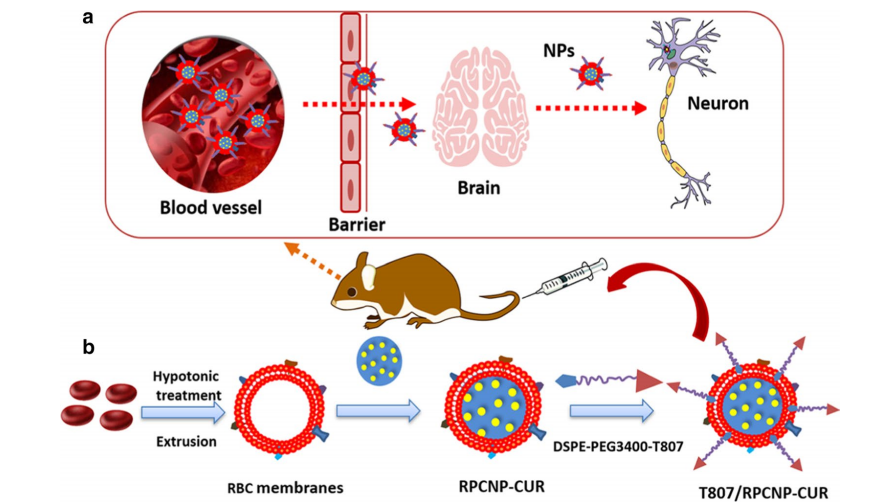文献:Neuron tau-targeting biomimetic nanoparticles for curcumin delivery to delay progression of Alzheimer's disease
文献链接:https://xueshu.baidu.com/usercenter/paper/show?paperid=1p5j0cu0wd4f0240v32q0mn0au750509&site=xueshu_se
作者:Chunhong Gao, Xiaoyang Chu, Wei Gong, Jinpeng Zheng , Xiangyang Xie, Yuli Wang, Meiyan Yang, Zhiping Li, Chunsheng Gao and Yang Yang
相关产品:DSPE-PEG3400-NHS 磷脂-聚乙二醇3400-活性酯
原文摘要:Background: Although many therapeutic strategies for Alzheimer’s disease (AD) have been explored, these strategies are seldom used in the clinic. Therefore, AD therapeutic research is still urgently needed. One major challenge in the feld of nanotherapeutics is to increase the selective delivery of drugs to a targeted location. Herein, we devised and tested a strategy for delivery of nanoparticles to neurons to inhibit tau aggregation by directly targeting p-tau.
Results: Curcumin (CUR) is loaded onto red blood cell (RBC) membrane-coated PLGA particles bearing T807 molecules attached to the RBC membrane surface (T807/RPCNP). With the advantage of the suitable physicochemical properties of the PLGA nanoparticles and the unique biological functions of the RBC membrane, the RPCNP are stabilized and promote sustained CUR release, which provided improved biocompatibility and resulted in long-term presence in the circulation. Under the synergistic efects of T807, T807/RPCNP can not only efectively penetrate the blood–brain barrier (BBB), but they also possess high binding afnity to hyperphosphorylated tau in nerve cells where they inhibit multiple key pathways in tau-associated AD pathogenesis. When CUR was encapsulated, our data also demonstrated that CUR-loaded T807/RPCNP NPs can relieve AD symptoms by reducing p-tau levels and suppressing neuronal-like cells death both in vitro and in vivo. The memory impairment observed in an AD mouse model is signifcantly improved following systemic administration of CUR-loaded T807/RPCNP NPs.
Conclusion: Intravenous neuronal tau-targeted T807-modifed novel biomimetic nanosystems are a promising clinical candidate for the treatment of AD.
DSPE-PEG3400-NHS是一种功能化的磷脂-聚乙二醇衍生物,在化学组成上,DSPE部分为1,2-二硬脂酰-sn-甘油-3-磷酸乙醇胺,它是一种具有双碳氢链的磷脂,这种结构使其具亲脂性,能够与细胞膜等脂质结构相互作用。中间的PEG3400链段是聚乙二醇,其分子量约为3400,能赋予材料良好的水溶性和柔性。这使得整个分子既具有亲水性又有亲脂性。
NHS(N-羟基琥珀酰亚胺)基团则是其活性官能团。它可以与含有氨基的分子(如蛋白质、多肽等)在温和的条件下发生反应,形成稳定的酰胺键。DSPE-PEG3400-NHS在制备化合物载体、生物传感器以及对生物分子进行修饰等方面有应用前景,可用于改善生物分子的溶解性、稳定性和靶向性等。小编引用的本篇文献通过靶向p-tau蛋白将纳米颗粒注入tau神经元来抑制tau聚集,增加化合物到靶向位置的选择性传递。过程如下:

图:T807/RPCNP-CUR在体内的解释示意图。
DSPE-PEG3400-T807的合成
将氨基t807溶解在氯仿中,并以氨基t807与脂质的摩尔加入到DSPE-PEG3400- NHS中。Te混合物在室温下在黑暗中轻轻搅拌过夜。对Te合成的上清液进行透析用蒸馏水浸泡48小时。Te纯化的透析液冻干,−20°C保存。收集RBCm用低渗溶液处理,然后将收获的RBCm通过超声波分散。Te获得的囊泡随后通过聚碳酸酯多孔膜连续挤压,然后在PBS中保存直到使用。
PLGA纳米颗粒的制备
将PLGA和CUR或疏水探针(DIR或COU 6)加入到丙酮混合物中。完全溶解后,将混合物倒入PBS混合溶液中用超声波乳化混合物,然后通过旋转蒸发器去除丙酮溶剂,形成装载cur的PLGA NPs或疏水探针标记的PLGA NPs。
T807-RPCNP纳米颗粒的制备
将DSPE-PEG3400- T807和RPCNPs混合在 PBS溶液中,然后进行超声处理。Te棕色悬浮液在注射器中搅拌。除去多余的PEG3400-T807,用透析袋彻底纯化T807-RPCNPs。

图:DSPE-PEG3400-T807的制备
结论:CUR被装载到PLGA颗粒上,这些颗粒上有T807分子附着在RBC膜表面(T807/RPCNP)。由于PLGA纳米颗粒合适的物理化学性质和RBC膜生物学功能,RPCNP能够稳定并促进CUR的持续释放,这提供了更好的生物相容性,并导致在循环中长期存在。在T807的协同作用下,DSPE-PEG3400-NHS参与制备的T807/RPCNP不仅能穿透BBB,而且与神经细胞中过度磷酸化的tau蛋白具有较高的结合能力。

 2025-02-13 作者:ZJ 来源:
2025-02-13 作者:ZJ 来源:

